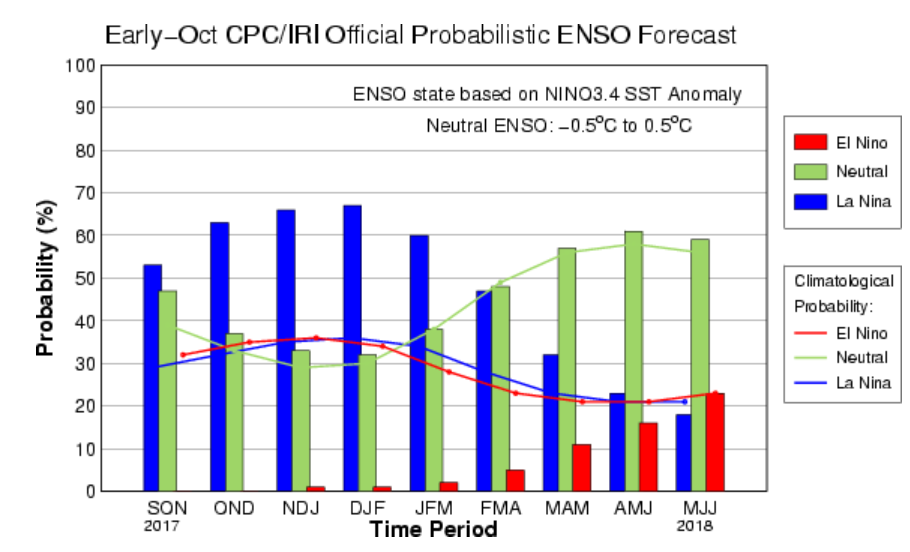
Probabilities chart for the different ENSO phases in the coming months. The blue bars represent the probability of La Niña with the highest probability (over 66%) from November through February. Source: International Research Institute
Clyde Fraisse, AgroClimate Project Director
While ENSO-Neutral conditions are still present in the Pacific Ocean, a La Niña Watch was issued by the NOAA Climate Prediction Center (CPC) on October 9, 2017. The chances for a La Nina to develop this Fall are around 60%, so this is a good time for growers to review potential effects of La Niña events on Florida’s climate and agricultural commodities. It is good to keep in mind that, while every La Niña event is different, they typically bring a warmer and drier fall and winter seasons (October through March) to Florida, central and lower Alabama and central and southern Georgia. La Niña events in 1999 and 2000, 2006 and more recently in early 2012, were associated with an increase in forest fires across Florida and Georgia. La Niña is also known to be associated with an active tropical hurricane season.
Winter Vegetables
Tomato and green pepper yields are generally higher during La Niña years than during Neutral or El Niño years. Dry weather generally decreases fungal and bacterial diseases and allow growers to reduce the number of fungicide applications, however viruses caused by thrips (Tomato Spotted Wilt [TSW]) and white fly (Tomato Yellow Leaf Curl [TYLCV]) are problems. High nighttime temperatures (above 65°F) can also be a problem for fruit setting.
Row Crops
La Niña impacts are less evident on annual summer crops, since its strongest signal occurs during fall, winter and spring. Warm conditions may help certain pests and diseases. Warm, dry winter may increase flower thrips abundance. Yellow mustard and wild pansy are ideal hosts for thrips, and a warm winter may provide ideal growing conditions for these and many other host plants. Warm conditions may also help soybean rust over-winter on kudzu in South Georgia and throughout the Panhandle of Florida. If conditions are dry during the spring, it may be best to kill cover crops earlier in order to preserve more moisture in the soil.
Winter Pasture
Success of winter pastures depends on rainfall. This is especially true when overseeding. In central and south peninsular Florida, overseeding of cool-season annuals into a established grass sod often fails due to insufficient soil moisture. Overseeding is generally not recommended unless irrigation is available, since dry conditions can be exacerbated during La Niña seasons.
Temperate Fruits
Seasonal climate variability impacts deciduous fruit production mainly through changes in the satisfaction of dormancy that occurs by the accumulation of chilling hours (temperature at or below 45°F) and changes in the accumulation of heat units that promote flowering and fruit development. Also affected can be the extent of the threat from freeze damage during flower and fruit development, and the timing and severity of diseases and pests. If La Niña conditions develop this winter it may result in significant decrease in overall chill accumulation.
The dry weather during La Niña years is usually not conducive to fungal diseases, such as Anthracnose and Botrytis fruit rots. In the case of strawberry, these are the two major diseases of concern. During La Niña expected drier conditions, regular applications of fungicides may not be needed as often to suppress these diseases, especially when moderately or highly resistant cultivars are grown. So, it may be a good opportunity for growers to extend spray intervals and reduce fungicide costs without a great risk of compromising their profits.
Winter annual broadleaf weeds may thrive under warm and dry conditions, and these weeds act as host plants for catfacing insects (sucking bugs) of peaches. High populations of cat-facing insects have been documented in peach orchards where winter annual broadleaf weeds are allowed to grow.
Forestry
Warm and dry conditions associated with La Niña events may prompt managers to consider re-scheduling planting of drought vulnerable seedlings, reinforce existing control efforts of southern pine beetle, and delay the harvest of pine straw to retain soil moisture. La Niña also brings the potential for a very active wildfire season. Average acreage burned during La Niña years is often more than doubled as seen in 1998 and 2001.
 For more information about of the potential effects of La Niña to the agricultural industry, and on rainfall and temperature patterns in your county visit the AgroClimate website at http://www.agroclimate.org
For more information about of the potential effects of La Niña to the agricultural industry, and on rainfall and temperature patterns in your county visit the AgroClimate website at http://www.agroclimate.org
